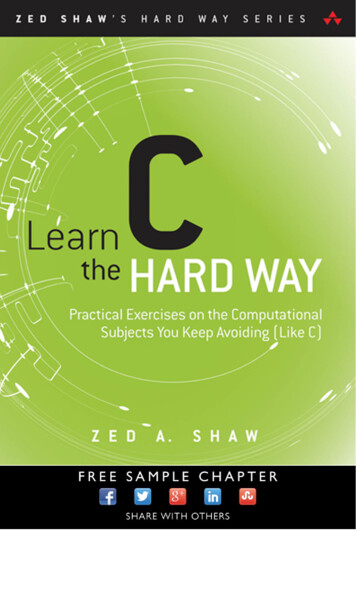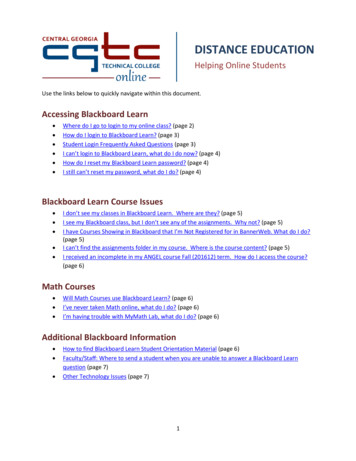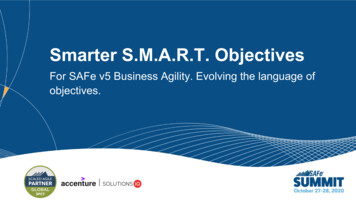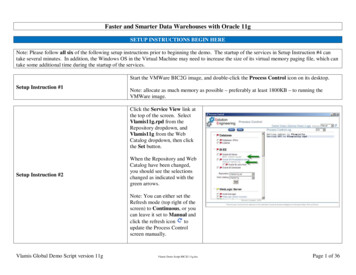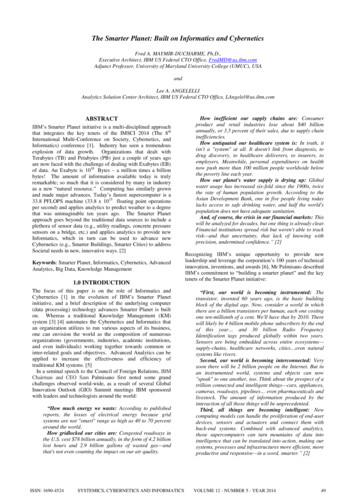
Transcription
A Smarter Way to Learn JavaScriptThe new approach that uses technology to cut your effort in halfMark Myerscopyright 2013 by Mark Myers2
Chapters1. Alerts2. Variables for Strings3. Variables for Numbers4. Variable Names Legal and Illegal5. Math Expressions: familiar operators6. Math Expressions: unfamiliar operators7. Math Expressions: eliminating ambiguity8. Concatenating text strings9. Prompts10. if statements11. Comparison operators12. if.else and else if statements13. Testing sets of conditions14. if statements nested15. Arrays16. Arrays: adding and removing elements17. Arrays: removing, inserting, and extracting elements18. for loops19. for loops: flags, Booleans, array length, and breaks20. for loops nested21. Changing case22. Strings: measuring length and extracting parts23. Strings: finding segments24. Strings: finding a character at a location25. Strings: replacing characters26. Rounding numbers27. Generating random numbers28. Converting strings to integers and decimals29. Converting strings to numbers, numbers to strings30. Controlling the length of decimals31. Getting the current date and time32. Extracting parts of the date and time33. Specifying a date and time34. Changing elements of a date and time35. Functions36. Functions: passing them data37. Functions: passing data back from them38. Functions: local vs. global variables39. switch statements: how to start them40. switch statements: how to complete them3
41. while loops42. do.while loops43. Placing scripts44. Commenting45. Events: link46. Events: button47. Events: mouse48. Events: fields49. Reading field values50. Setting field values51. Reading and setting paragraph text52. Manipulating images and text53. Swapping images54. Swapping images and setting classes55. Setting styles56. Target all elements by tag name57. Target some elements by tag name58. The DOM59. The DOM: Parents and children60. The DOM: Finding children61. The DOM: Junk artifacts and nodeType62. The DOM: More ways to target elements63. The DOM: Getting a target's name64. The DOM: Counting elements65. The DOM: Attributes66. The DOM: Attribute names and values67. The DOM: Adding nodes68. The DOM: Inserting nodes69. Objects70. Objects: Properties71. Objects: Methods72. Objects: Constructors73. Objects: Constructors for methods74. Objects: Prototypes75. Objects: Checking for properties and methods76. Browser control: Getting and setting the URL77. Browser control: Getting and setting the URL another way78. Browser control: Forward and reverse79. Browser control: Filling the window with content80. Browser control: Controlling the window's size and location81. Browser control: Testing for popup blockers82. Form validation: text fields4
83. Form validation: drop-downs84. Form validation: radio buttons85. Form validation: ZIP codes86. Form validation: email87. Exceptions: try and catch88. Exceptions: throw89. Handling events within JavaScript5
How I propose tocut your effort in halfby using technology.When you set out to learn anything as complicated as JavaScript, you sign up for someheavy cognitive lifting. If I had to guess, I'd say the whole project of teaching yourself alanguage burns at least a large garden-cart load of brain glucose. But here's what you may notrealize: When you teach yourself, your cognitive load doubles.Yes, all the information is right there in the book if the author has done a good job. Butlearning a language entails far more than reading some information. You need to commit theinformation to memory, which requires some kind of plan. You need to practice. How are yougoing to structure that? And you need some way to correct yourself when you go off-course.Since a book isn't the best way to help you with these tasks, most authors don't even try. Whichmeans all the work of designing a learning path for yourself is left to you. And this do-ityourself meta-learning, this struggle with the question of how to master what the book is tellingyou, takes more effort than the learning itself.Traditionally, a live instructor bridges the gap between reading and learning. Taking acomprehensive course or working one-on-one with a mentor is still the best way to learnJavaScript if you have the time and can afford it. But, as long as many people prefer to learn ontheir own, why not use the latest technology as a substitute teacher? Let the book lay out theprinciples. Then use an interactive program for memorization, practice, and correction. Whenthe computer gets into the act, you'll learn twice as fast, with half the effort. It's a smarter wayto learn JavaScript. It's a smarter way to learn anything.And as long as we're embracing new technology, why not use all the tech we can get ourhands on to optimize the book? Old technology—i.e. the paper book—has severe limitationsfrom an instructional point of view. New technology—i.e. the ebook—is the way to go, formany reasons. Here are a few:Color is a marvelous information tool. That's why they use it for traffic lights. But printingcolor on paper multiplies the cost. Thanks to killer setup charges, printing this single word—color—in a print-on-demand book adds thirty dollars to the retail price. So color is usuallyout, or else the book is priced as a luxury item. With an ebook, color is free.Paper itself is expensive, so there usually isn't room to do everything the author wouldlike to do. A full discussion of fine points? Forget it. Extra help for the rough spots? Can'tafford it. Hundreds of examples? Better delete some. But no such limitation applies to anebook. What do an extra hundred digital pages cost? Usually nothing.When a book is published traditionally, it may take up to a year for the manuscript to getinto print. This means there isn't time for extensive testing on the target audience, or for therevisions that testing would inevitably suggest. And once the book is in print, it's a big,6
expensive deal to issue revised editions. Publishers put it off as long as possible. Readerfeedback usually doesn't lead to improvements for years. An ebook can go from manuscript tobook in a day, leaving lots of time for testing and revision. After it's published, new editionswith improvements based on reader feedback can come out as often as the author likes, at nocost.With all this going for them, is there any doubt that all the best instructional books aregoing to be ebooks? And would anyone deny that the most helpful thing an author can do foryou, in addition to publishing a good book electronically, is to take on the whole teaching job,not just part of it, by adding interactivity to help you with memorization, practice, andcorrection?Here, then, is how I propose to use current technology to help you learn JavaScript in halfthe time, with half the effort.Cognitive portion control. Testing showed me that when they're doing hard-corelearning, even strong-minded people get tired faster than I would have expected. You maybe able to read a novel for two hours at a stretch, but when you're studying something newand complicated, it's a whole different ballgame. My testing revealed that studying newmaterial for about ten minutes is the limit, before most learners start to fade. But here's thegood news: Even when you've entered the fatigue zone after ten minutes of studying,you've still got the mental wherewithal to practice for up to thirty minutes. Practice that'sdesigned correctly takes less effort than studying, yet teaches you more. Reading a littleand practicing a lot is the fastest way to learn.500 coding examples that cover every aspect of what you're learning. Examples makeconcepts easy to grasp and focus your attention on the key material covered in eachchapter. Color cues embedded in the code help you commit rules to memory. Did I gooverboard and put in more examples that you need? Well, if things get too easy for you,just skip some them.Tested on naive users. The book includes many rounds of revisions based on feedbackfrom programming beginners. It includes extra-help discussions to clarify concepts thatproved to be stumbling blocks during testing. Among the testers: my technophobe wife,who discovered that, with good instruction, she could code—and was surprised to findthat she enjoyed it. For that matter, I got a few surprises myself. Some things that aresimple to me turned out not to be not so simple to some readers. Rewriting ensued.Free interactive coding exercises paired with each chapter—1,750 of them in all.They're the feature that testers say helps them the most. No surprise there. According tothe New York Times, psychologists "have shown that taking a test—say, writing down allyou can remember from a studied prose passage—can deepen the memory of that passagebetter than further study." I would venture that this goes double when you're learning tocode. After reading each chapter, go online and practice everything you learned. Eachchapter ends with a link to its accompanying online exercises. Find an index of all theexercises at http://www.ASmarterWayToLearn.com/js/.7
Live coding experience. In scripting, the best reward is seeing your code run flawlessly.Most practice sessions include live coding exercises that let you see your scripts executein the browser.8
How to use this bookThis isn't a book quite like any you've ever owned before, so a brief user manual might behelpful.Study, practice, then rest. If you're intent on mastering the fundamentals of JavaScript,as opposed to just getting a feel for the language, work with this book and the onlineexercises in a 15-to-30-minute session, then take a break. Study a chapter for 5 to 10minutes. Immediately go online at http://www.ASmarterWayToLearn.com/js and code for10 to 20 minutes, practicing the lesson until you've coded everything correctly. Then gofor a walk.Use the largest, most colorful screen available. This book can be read on small phonescreens and monochrome readers, but you'll be happier if things appear in color on alarger screen. I use color as an important teaching tool, so if you're reading in black-andwhite, you're sacrificing some of the extra teaching value of a full-color ebook. Coloredelements do show up as a lighter shade on some black-and-white screens, and on thosedevices the effect isn't entirely lost, but full color is better. As for reading on a largerscreen— the book includes more than 2,000 lines of example code. Small screens breaklong lines of code into awkward, arbitrary segments, jumbling the formatting. While stilldecipherable, the code becomes harder to read. If you don't have a mobile device that'sideal for this book, consider installing the free Kindle reading app on your laptop.If you're reading on a mobile device, go horizontal. For some reason, I resist doing thison my iPad unless I'm watching a video. But even I, Vern Vertical, put my tablet intohorizontal mode to proof this book. So please: starting with Chapter 1, do yourself afavor and rotate your tablet, reader, or phone to give yourself a longer line of text. It'llhelp prevent the unpleasant code jumble mentioned above.Do the coding exercises on a physical keyboard. A mobile device can be ideal forreading, but it's no way to code. Very, very few Web developers would attempt to dotheir work on a phone. The same thing goes for learning to code. Theoretically, most ofthe interactive exercises could be done on a mobile device. But the idea seems soperverse that I've disabled online practice on tablets, readers, and phones. Read the bookon your mobile device if you like. But practice on your laptop.If you have an authority problem, try to get over it. When you start doing theexercises, you'll find that I can be a pain about insisting that you get every little detailright. For example, if you indent a line one space instead of two spaces, the programmonitoring your work will tell you the code isn't correct, even though it would still runperfectly. Do I insist on having everything just so because I'm a control freak? No, it'sbecause I have to place a limit on harmless maverick behavior in order to automate the9
exercises. If I were to grant you as much freedom as you might like, creating thealgorithms that check your work would be, for me, a project of driverless-carproportions. Besides, learning to write code with fastidious precision helps you learn topay close attention to details, a fundamental requirement for coding in any language.Subscribe, temporarily, to my formatting biases. Current code formatting is likeseventeenth-century spelling. Everyone does it his own way. There are no universallyaccepted standards. But the algorithms that check your work when you do the interactiveexercises need standards. They can't grant you the latitude that a human teacher could,because, let's face it, they aren't that bright. So I've had to settle on certain conventions.All of the conventions I teach are embraced by a large segment of the coding community,so you'll be in good company. But that doesn't mean you'll be married to my formattingbiases forever. When you begin coding projects, you'll soon develop your own opinionsor join an organization that has a stylebook. Until then, I'll ask you to make your code looklike my code.Email me with any problems or questions. The book and exercises have been tested onmany learners, but haven't been tested on you. If you hit a snag, if you're just curious aboutsomething, or if I've found some way to give you fits, email me atmark@ASmarterWayToLearn.com. I'll be happy to hear from you. I'll reply promptly.And, with your help, I'll probably learn something that improves the next edition.10
1AlertsAn alert is a box that pops up to give the user a message. Here's code for an alert thatdisplays the message "Thanks for your input!"alert("Thanks for your input!");is a keyword—that is, a word that has special meaning for JavaScript. It means,"Display, in an alert box, the message that follows." Note that alert isn't capitalized.
Here's how it works. 1 function greetWorld() { 2 try { 3 var greeting "Hello world!"; 4 aler(greeting); 5 } 6 catch(err) { 7 alert(err); 8 } 9 } The original operational code is wrapped in the tryblock. The mis-formed alercauses a JavaScript error, which is passed to the catchblock.File Size: 1MBPage Count: 288Explore furtherLearning JavaScript, 3rd Edition [PDF] - Programmer quentjavascript.netJavaScript Basics - GitHub Pagesautotelicum.github.ioAbout the oquentjavascript.netRecommended to you based on what's popular Feedback


